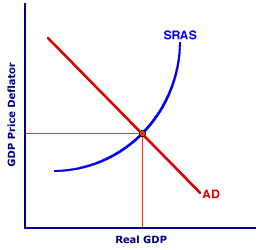
|
|
LEGAL FORCES: Forces in the marketing environment that are shaped by government laws affecting business. These are very similar to political forces. Once laws are enacted they are usually very difficult to change. Many companies work hard at lobbying legislatures, Congress, and other elected to pass laws favorable to the company's best interests.
Visit the GLOSS*arama
|
|


|

|
                           EQUILIBRIUM, SHORT-RUN AGGREGATE MARKET: The state of equilibrium that exists in the short-run aggregate market when real aggregate expenditures are equal to full-employment real production with no imbalances to induce changes in the price level or real production. The opposing forces of aggregate demand (the buyers) and short-run aggregate supply (the sellers) exactly offset each other. At the existing price level, the four macroeconomic sectors (household, business, government, and foreign) purchase all of the real production that they seek and producers sell all of the real production that they have. While the focus of equilibrium in the short-run aggregate market is on balance between real expenditures and real production in the product markets, it also involves simultaneous equilibrium in the aggregated financial markets but not in the aggregated resource markets. Short-run price rigidity means that resource markets are out of balance, with either surpluses (unemployment) or shortages (overemployment). Short-run equilibrium is one of two macroeconomic equilibrium alternatives found in aggregate market analysis. The other is equilibrium in the long-run aggregate market, which has equilibrium in all three aggregated markets--product, financial, and resource.Equilibrium
Short-Run Aggregate Market |  |
This graph to the right can be used to illustrate equilibrium in the short-run aggregate market. First, to set up the graph, the vertical axis measures the price level (GDP price deflator) and the horizontal axis measures real production (real GDP). The negatively-sloped curve, labeled AD, is the aggregate demand curve and the positively-sloped curve, labeled SRAS, is the short-run aggregate supply curve. Short-run equilibrium is the price level and real production obtained at the intersection of the AD and SRAS curves.Because the SRAS curve is positively-sloped, short-run equilibrium can occur at ANY level of real production. It need NOT be full employment. To demonstrate that short-run equilibrium can occur at different levels of real production should aggregate demand change, click the [AD Increase] and [AD Decrease] buttons. An increase in aggregate demand leads to a higher price level AND an increase in real production. A decrease in aggregate demand leads to a lower price level AND a decrease in real production. Short-run aggregate market equilibrium means the economy has no wide-spread shortages or surpluses in the product markets. However, this does not necessarily mean that ALL product markets are in equilibrium. A complex economy, like that in the United States, is bound to have shortages in some product markets and surpluses in others in short-run equilibrium. As such, prices in some markets rise, while those in other markets fall. These sorts of imbalances in specific markets reflect the ongoing reallocation of resources at the microeconomic level. What is required for aggregate market equilibrium at the macroeconomic level is that the microeconomic shortages and surpluses cancel out, that rising prices cancel falling prices, that the price level and real production do not change. By far the most important implication of short-run equilibrium is unemployment. Short-run price rigidity means that resource markets are out of balance, meaning either shortages or surpluses. In particular, there is some degree of cyclical unemployment or overemployment. This is why the SRAS curve is positively-sloped. At higher or lower price levels, real production can exceed or fall short of full-employment real production, resulting in overemployment or cyclical unemployment. And because short-run equilibrium can occur at ANY point on the SRAS curve, it need not be full employment. Another way of stating this is that the economy produces ANYTHING BUT full-employment real production in the short run. This implication of short-run full-employment is most important for government policies. If the economy is not producing full-employment real production in the short run, then stabilization policies from government can be used to improve the situation. The goal of stabilization policies is to achieve full employment. If the economy is not at full employment, then such policies can be useful. This role for government policies is warmly embraced by political liberals and others who prefer an active role for government in the economy.

Recommended Citation:EQUILIBRIUM, SHORT-RUN AGGREGATE MARKET, AmosWEB Encyclonomic WEB*pedia, http://www.AmosWEB.com, AmosWEB LLC, 2000-2025. [Accessed: July 18, 2025].
Check Out These Related Terms... | | | | | | | | |
Or For A Little Background... | | | | | | | | | | | | | | | | |
And For Further Study... | | | | | | | | | |
Search Again?
Back to the WEB*pedia
|



|

|
RED AGGRESSERINE
[What's This?]
Today, you are likely to spend a great deal of time at a flea market wanting to buy either a weathervane with a cow on top or a box of multi-colored, plastic paper clips. Be on the lookout for telephone calls from long-lost relatives.
Your Complete Scope
This isn't me! What am I?
|

|
|
Ragnar Frisch and Jan Tinbergen were the 1st Nobel Prize winners in Economics in 1969.
|

|
|
"A winner is someone who recognizes his God-given talents, works his tail off to develop them into skills, and uses those skills to accomplish his goals. " -- Larry Bird, basketball player
|

|
NYBOR
New York Interbank Offered Rate
|

|
|
Tell us what you think about AmosWEB. Like what you see? Have suggestions for improvements? Let us know. Click the User Feedback link.
User Feedback
|


|


